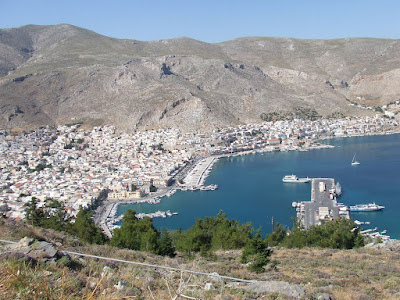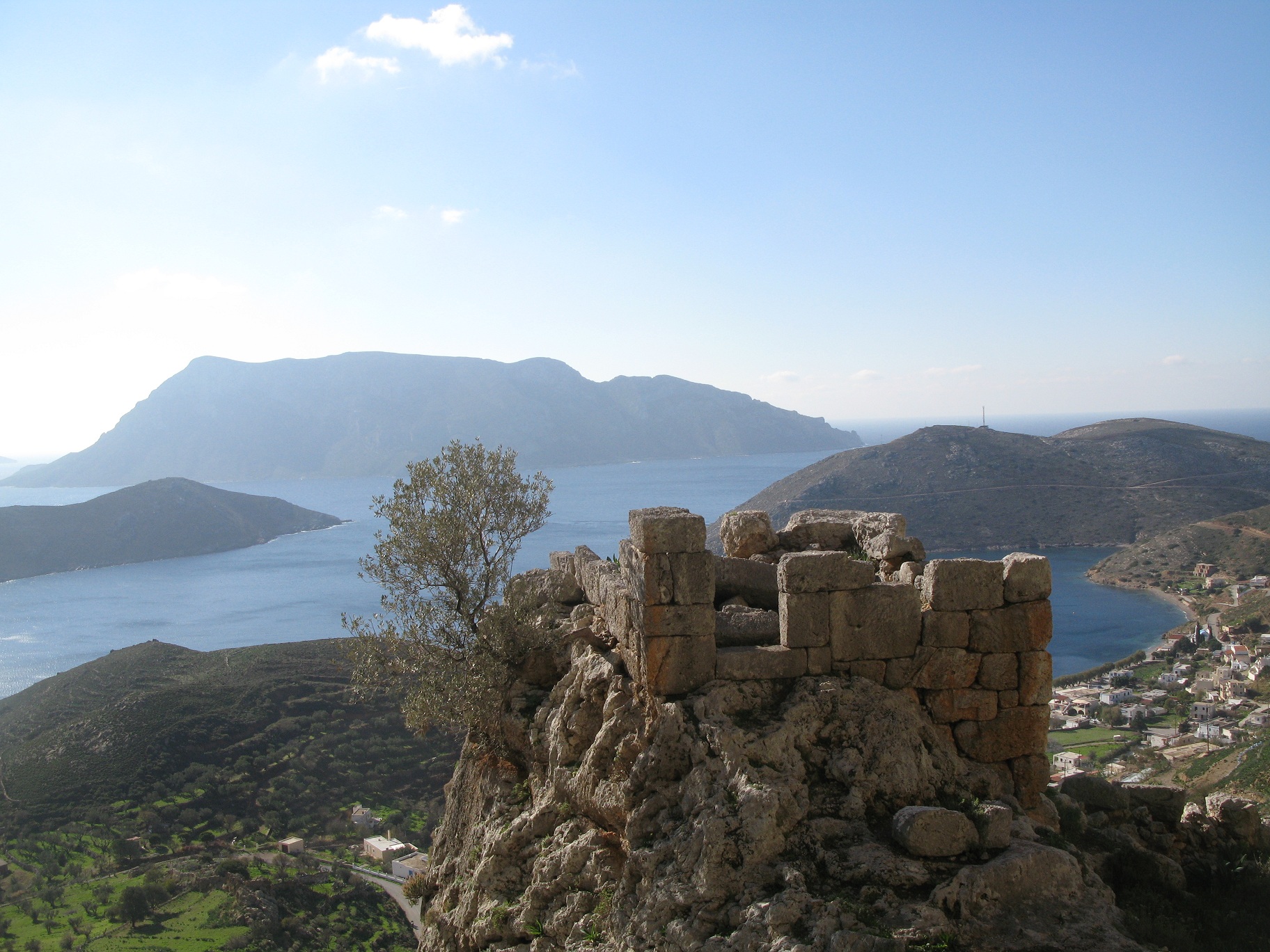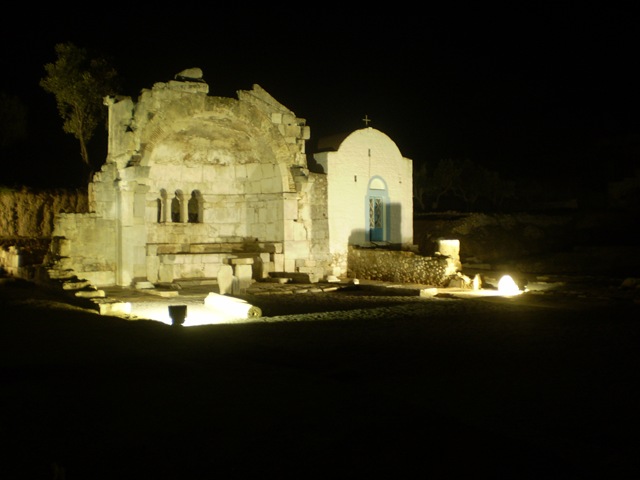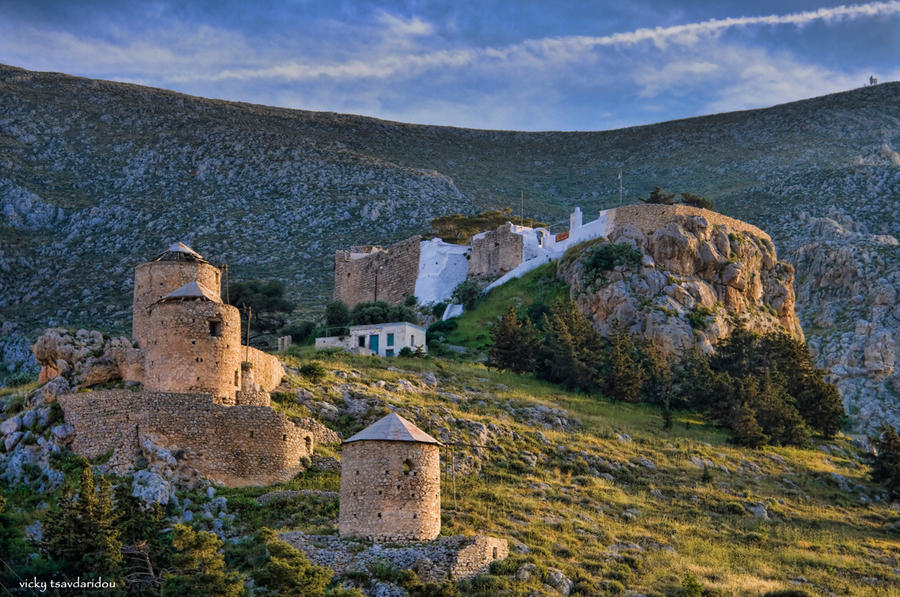
Archaic Age (700 – 480 B.C.)
Towards the end of the 6th century B.C. The Persians under their King Darius, had dominated the Greek cities in Asia Minor. Kalymnos as well as Kos were forced to pay a heavy tribute to Darius and became satellite states of his empire. Both islands however refused to take part in the Persian war against the rest of Greece which was still liberated. After the defeat of the Persians in 480 B.C. at the naval battle of Salamina and the total destruction of the Persian fleet at the Mykalis pass between the island of Samos and Asia Minor (479B.C.)
the Kalymnians expelled the Persian guards from their shores and thus rid themselves of the Persian yoke.
Classical Period (479 - 333B.C.)
During the Peloponnesian war; 431 - 404 B.C. the Kalymnians allied with the Athenians. During the war they were invaded by the Spartan admiral Astyocho, who did not however manage to install an oligarchic command faithful to Sparta and so Kalymnos soon returned to the Athenian alliance. Ιn 333 B.C. after the fall of Halicarnassus to Alexander the Great's generals (Ptolomeus, and Asantros) Kalymnos, like the surrounding islands, was delivered from the Halicarnassus domination.
The Greek cities were declared independent states and became allies of Alexander the Great in his war against the Persians.
Hellenistic Age (333-30 B.C)
From 220 to 215 B.C. Kalymnos is subject to Kos which together with Rhodes and Rome, took part in the war against Phillip the 5th of Macedonia. (Not to be confused with FYROM or Skopje which has usurped the name in recent times.) Rome is the up and coming power of that age and takes full advantage of the disputes between Alexander the Great's successors to further extend its supremacy.
The Byzantine Period (333-1309 A.D.)
In 554 A.D. one of the most terrible earthquakes ever occurred. The earth shook for 14 days and is well documented by the historian Agathias who happened to be in Kos at the time. The frightening tremors and explosions made the earth subside and the sea rushed in and ravished the coastline taking with it people, buildings and anything else in its way. In 1306 A.D. kalymnos is conquered by the Knights of the Order of Saint John from Jerusalem.
The order has Rhodes as it's administrative capital which it managed to subdue after three years of resistance by the Rhodians.
The Turkish Domination (1523 - 1912)
In 1523 A.D. the Kalymnians that were still left on the island (since the defence of Kos and Rhodes had stripped Kalymnos bare of most of its able warriors and since the Knights of the Order of Saint John had abandoned them) and after witnessing the pillaging, looting and the general slaughter that the Turks were committing, they decided that any more sacrifice of Kalymnian life would be pointless and therefore surrendered. On the 29th of August 1824, the day of the great naval battle between the Greek fleet under the command of Admiral Miaoulis
and the Turkish fleet under the command of Admiral Chosref Pasha, a battle which took place at the gulf of Geronta, the Kalymnians gathered at the peak of Mount Prophetis Elias (Prophet Elijah) and remained on their knees in prayer for the victory of the Greek fleet as they watched the battle unfold below. When they received the news that the battle had been won, their indescribable joy manifested itself in the form of patriotic singing and dancing.
Modern History (1912 to present)
On the 12th of March 1912, Italian war ships disembarked landing parties in Kalymnos. Italy was at war with Turkey over Tripolitida which it managed to conquer and was now expanding its influence in the Dodecanese Islands. The Kalymnians welcomed the Italians as liberators and as brothers but their hopes were quickly shattered as the great powers couldn't or wouldn't enforce a fair solution. The Italian occupation became particularly cruel during the fascist years. In the decade of the 1930's many leading Kalymnian citizens were imprisoned and banished
from the island. The teaching of Greek as a language was banned from all schools and Kalymnians like the rest of the Dodecanese people under Italian occupation were considered second class citizens with no real substantial human rights. The men of the island were always ready to pick a fight with the well armed fascists. Confrontations were frequent and often broke out into violence. During the second world war, after the fall of Italy in 1943, the island was conquered by the Germans. A new reign of terror began as Kalymnos was forced to abandon the allies. On the 7th of March 1948 the unification of the island with the rest of Greece was made official. Finally, the yearning to be reunited with Greece, after many centuries of struggle and sacrifice, had become reality for the Kalymnian people.


Mythology of Kalymnos
According to myth, Uranus and Gaia had many children; the Giants, the Titans (which ruled the earth before they were deposed by Zeus and his brothers), the Cyclops (which had one eye) and the Ekatocheires (which had a hundred hands). Uranus was aware that legend said that one of his sons would eventually depose him and he decided to throw them all into Tartarus, the centre of the earth. Kalyndos, one of his sons, fell on a piece of land which emerged back to the surface and formed a large island surrounded by smaller islets, fragments of the piece of land that Kalyndos landed on. The island was aptly named the island of Kalyndos. Today the islets surround the island of Kalymnos. When one looks down on Kalymnos from above, one can see two large mountains and two small valleys which are said to resemble the legs of Kalyndos. Kalyndos was, according to myth, originally the god of Hades but later became the god of the sea although nothing to suggest that he was worshiped has ever been discovered. The first inhabitants of Kalymnos were the Kares, Leleges and the Pelasgui.
Sightseeing
Kastri


Sanctuary of Diliou Apollo



Settlement Hellinica
In the Paleo-Christian Era (4th - early 7th century AD), Vathis flourished more than ever. It was the largest settlement surrounding the port of Rina in the southern part, named Hellenica. Churches, houses and arched graves have been kept in remarkable condition in some cases up to roof height. In Vathi there are ruins of thirteen Paleo-Christian Churches. These are: Agia Sophia (Saint Sophia), Anastasi (Resurrection), Agios Georgios (Saint George), Agia Irini (Saint Irene), Vasiliki Ikopedou Chalkiti, Unknown Church, Paleopanagia,
Holly Cross, Taxiarchis, Pano Panagia, Agios Antonios (Saint Antonio) and Agia Anna (Saint Anna).
The Castle of Chora




The Castle of Chrisocherias

Museums
Museum of Marine Life and Findings
The Museum is located at the seaside village of Vlichada. It is a private museum, where exhibits related to sponge fishery are displayed, also a large variety of plants and animals from the marine kingdom and numerous amphorae and other objects from old shipwrecks are presented. The findings deriving from various sea dives include almost everything one can encounter in the deep blue. Part of the museum is dedicated to the sponge fishery profession and includes all of the diving equipment used by divers since 1872 until today.
Traditional House of Kalymnos
It is located on the southern edge of the Monastery of All Saints, in Vothini. It is a private Folk Museum of Mrs. Skilla Chalkidiou Faneromeni with many folklore objects and chattels of old households. Visitors get the opportunity to learn about the form and organization of everyday life which took place in a traditional urban house of the late 19th and the early 20th century. Mrs Faneromeni Skylla who is a daughter of a sponge fisherman loved this place and wanted provide every visitor with pictures of “yesterday” and to talk about “her Kalymnos”.
Municipal Nautical Museum
At the Municipal Navy Museum the visitors can learn about the maritime tradition of the island and the history and methods of sponge fishery. Also there are objects from ancient ship wrecks. The Laografiko Museum (Folklore Museum) operates in the same building, exhibiting cultural samples of Kalymnos folklore. The Municipal Navy Museum of Kalymnos actually is the only museum of sponge fishery in Greece. In the museum visitors can see the progress and development of the diving methods and also the tools that were used for sponge fishery
Archaeological Museum of Kalymnos



Agia Triada quarter, 85200 KALYMNOS , DODEKANISSOS , GREECE
Tel.: +30 22430 23113, 59092
Fax: +30 22430 23113, 59092
E-mail: kbepka@culture.gr
URL: http://odysseus.culture.gr/h/1/gh152.jsp...
Opening hours:01Jun - 31Oct Tue-Sun, 0900-1600

Δεν υπάρχουν σχόλια:
Δημοσίευση σχολίου